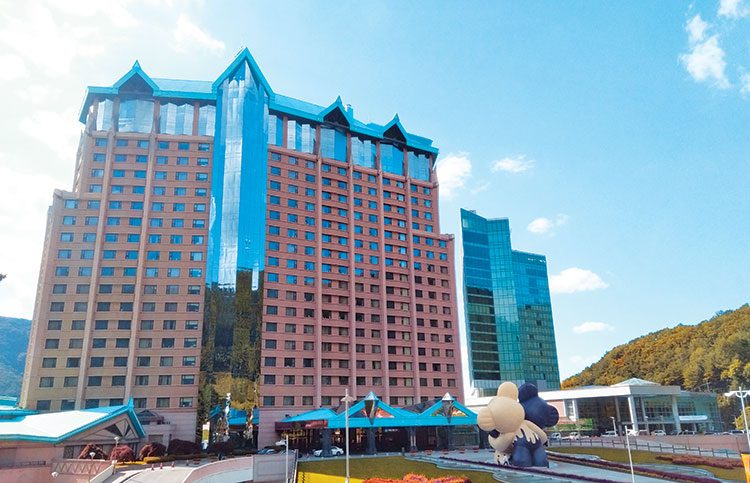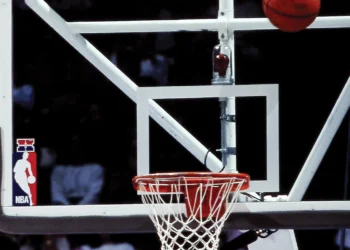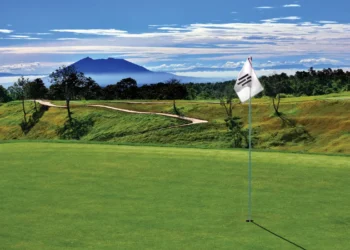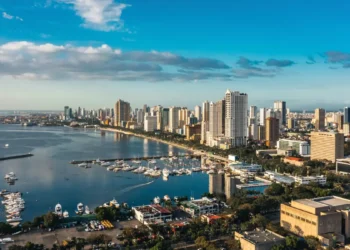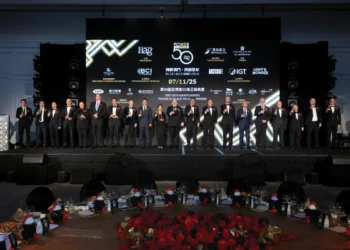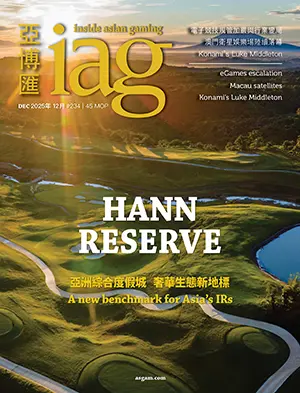Korea’s only casino accessible casino without a foreign passport draws crowds despite efforts to curtail play.
This table had a wheel, just like a roulette table. But where you’d expect the betting layout, there was just a thick, lumpy blanket of chips, with another blanket where you’d expect another layout on the other side of the wheel.
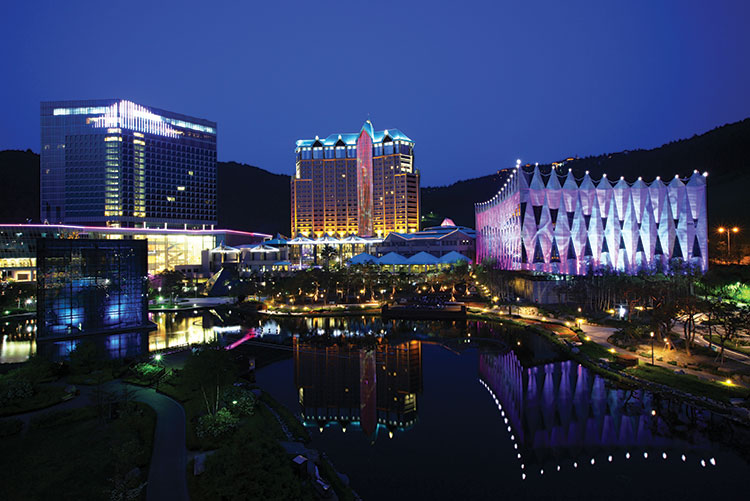 Within a minute, the wheel stopped spinning, the chips were cleared and, voila, a normal layout appeared where all of those chips had obscured any hint of the numbers.
Within a minute, the wheel stopped spinning, the chips were cleared and, voila, a normal layout appeared where all of those chips had obscured any hint of the numbers.
Welcome to Kangwon Land, the only casino in South Korea where Koreans can play without showing a foreign passport and where, even in a down year after table reductions, dealer shortages and curtailed hours, gross gaming revenue surpassed US$1.1 billion, more than the combined total of Korea’s 16 foreigner-only casinos.
Located 150 kilometers (93 miles) from Seoul, Kangwon Land emerged from Korea’s conversion to gas and oil for energy, leading to the closure of mines in Gangwon province in 1989. Legislation in 1995 encouraged redevelopment of abandoned mining areas, prompting local, provincial and national authorities to found Kangwon Land Inc, 51% government owned and overseen by the national Ministry of Knowledge Economy, with remaining shares floated on the Korean stock exchange. With a monopoly on Korean play through 2025, ownership treads a delicate line between profitability and perceived social responsibility.
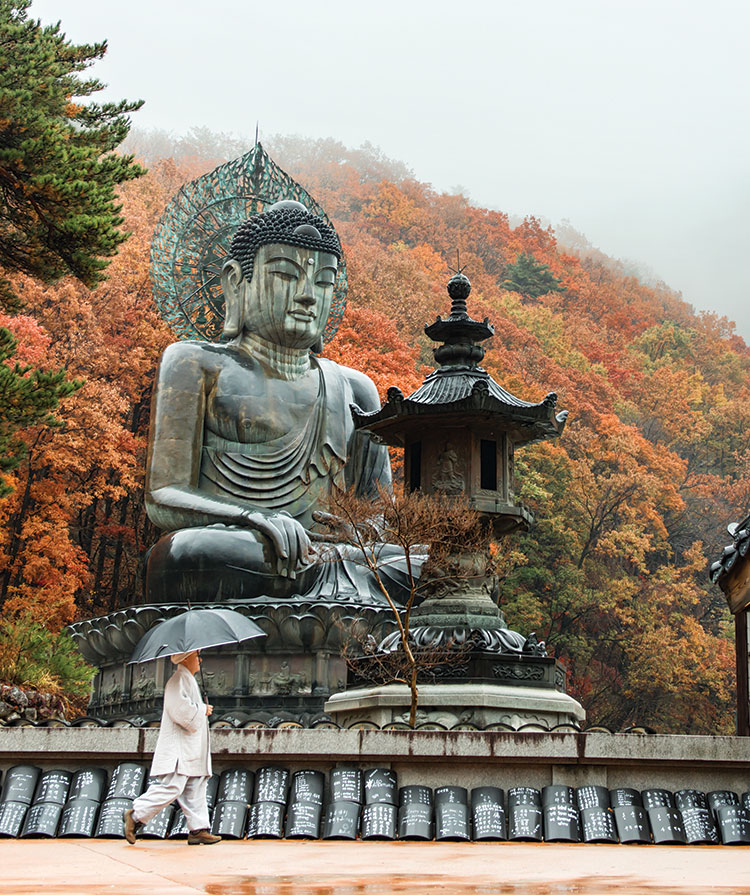 A 30 table, 480 machine casino and 197 room hotel opened in October 2000 at an elevation of 1,137 meters (3,730 feet). In April 2003, the current casino hotel complex opened down the hill, expanded to 100 tables, 960 machines and 477 guest rooms. Over a dozen years, the casino nudged upward to 200 tables and 1,360 machines over 12,792.95 square meters (137,702 square feet). The biggest move in 2014 added 68 tables, 400 machines and an upper level gaming floor accompanying a second hotel tower with 250 rooms aimed at convention business.
A 30 table, 480 machine casino and 197 room hotel opened in October 2000 at an elevation of 1,137 meters (3,730 feet). In April 2003, the current casino hotel complex opened down the hill, expanded to 100 tables, 960 machines and 477 guest rooms. Over a dozen years, the casino nudged upward to 200 tables and 1,360 machines over 12,792.95 square meters (137,702 square feet). The biggest move in 2014 added 68 tables, 400 machines and an upper level gaming floor accompanying a second hotel tower with 250 rooms aimed at convention business.
All of it is part of High1 Resort, with a footprint of 11.9 million square meters (2,941 acres), featuring Korea’s highest golf course, ski runs and hiking trails, plus hotels and condos with a total of 1,827 rooms. Last July, High1 opened Water World, an indoor/outdoor water park that officials say makes the resort a year round family destination.
HIGH HEALING
A spokesperson says CEO Moon Taegon, an auditor by trade halfway through a three-year term that began in December 2017, wants to make High1 a “healing resort” themed as a “national shelter with flowers, wind, forest and light.”
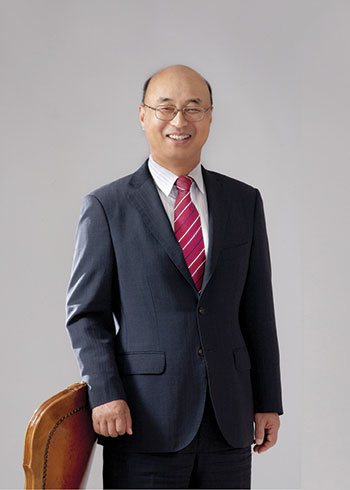
Improvements set to open before Moon steps down include a luge track, suspended glass walkway and performance fountain. A “Coal Mining Cultural Park” is also under development.
Thanks to road improvements linked to the 2018 Winter Olympics in nearby Pyeongchang, the drive to Kangwon Land from Seoul is less harrowing but still takes about three hours, and it’s a longer ride by train.
A casino visit starts with presenting your identification at the entry desk. If you’re Korean, you pay an entry fee of KRW9,000 (US$7.60) and receive a High1 club card, including your photo, if you don’t already have one. If you’re a foreigner, same drill, but you may not have to pay and may not get a card unless you ask. The card earns rewards from casino play and other spending at High1 that can be redeemed at the resort.
The office of the Kangwon Land Addiction Care Center is also located in the casino entry area; Kangwon Land says it pioneered the concept of onsite treatment for gambling disorders. The office is open daily until midnight, with peer counselors – all recovering addicts – present on and around the gaming floor throughout casino operating hours.
As part of responsible gaming efforts, Koreans are limited to 15 casino visits monthly, while local residents can enter only on the last Tuesday of every month. There’s no alcohol served on the gaming floor, though one fountain area dispenses a good vintage grape juice beside the orange and apple, plus tea, coffee and sodas.
CHEAP THRILLS
If you want a seat at a gaming table, use your High1 card to get on the waiting list, then join the throngs of back bettors until you get an assignment. Foreigners get shunted off to a corner of the floor with eight tables. Foreigners and Koreans alike can play tables games for as little as KRW1,000, less than US$1. At these prices, you can hardly afford not to play.
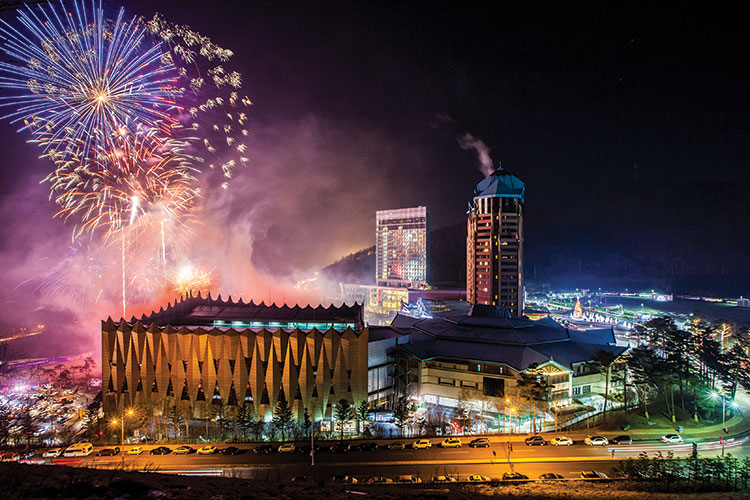 For Koreans, the main floor features 160 tables – minus the eight for foreigners – more than two-thirds blackjack or baccarat, a dozen roulette tables and a half-dozen sic bo tables, all with twin betting layouts, plus a smattering of other games such as casino war and three card poker. Minimum bets on the main gaming floor start at KRW1,000 with card games mostly KRW5,000 and KRW10,000. Maximums run from KRW50,000 (US$42) to KRW300,000 (US$252).
For Koreans, the main floor features 160 tables – minus the eight for foreigners – more than two-thirds blackjack or baccarat, a dozen roulette tables and a half-dozen sic bo tables, all with twin betting layouts, plus a smattering of other games such as casino war and three card poker. Minimum bets on the main gaming floor start at KRW1,000 with card games mostly KRW5,000 and KRW10,000. Maximums run from KRW50,000 (US$42) to KRW300,000 (US$252).
The Summitas Club VIP area has 20 tables, 16 for baccarat, four for blackjack. Kangwon Land doesn’t let slip many details on “membership play” in the 198 square meter club, but assures that VIP get nothing more than a room and meals while playing, certainly no rebates on chip purchases and definitely no credit. VIPs reportedly also get higher limits and special services such as concierge shopping. More than one-third of total casino revenue 15 years ago, VIP play comprised 15.5% of GGR last year.
LOW-LIMIT GAME
The eight table poker area requires a buy-in of KRW100,000 (US$84) to KRW1 million (US$840). The game is Texas Hold’em, not no-limit, but low-limit. Blinds are KRW2,000 and KRW5,000, with the bet raised to KRW10,000 for the turn and river. No more than two raises are allowed in any betting round except the last, when three raises are permitted, for a maximum final bet of KRW40,000.
The entrance level of the casino floor has the majority of gaming tables and all of the casino’s 1,360 electronic gaming terminals, including a 197-seat stadium area and a stunning variety of slot machines, none of which accept bets larger than KRW1,000.
At blackjack tables, there was little evidence of the infamous Kangwon rage prompted by poor play that can reduce to tears or shame away a player who splits tens or draws on 14 when the dealer shows a six. However, as a foreigner stood at a respectful distance observing play, a dealer barked, “Cannot watch.”
“When someone with authority tells me that, I’ll leave,” the foreigner replied, confident no one would understand, and continued sipping a grape juice.
NO SURRENDER
There are some other peculiarities in Kangwon Land blackjack compared with mainstream Macau or Manila casinos. There’s no surrender available, not that many of these gung-ho players would consider capitulation. Blackjack on splits only pays even money.
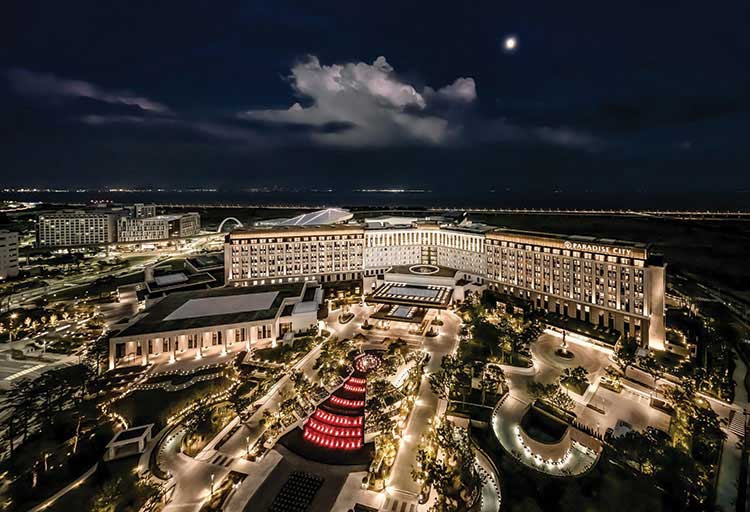
The high-ceiling original casino area near the entrance features a large Tiffany-style stained glass window and under it a Mint Bar selling chocolates, freshly made juices, teas and coffee for those not satisfied with mass produced stuff for free. Crystal Lounge serves up soup, sandwiches and sweets in its space age seating area. Pansy serves Korean mains for lunch and dinner with a salad bar that tells what kimchi is in season locally, plus a dessert and coffee buffet.
The two-level new gaming area has a brighter look and cleaner lines than the original. Its upper level has 64 tables and no machines, and the most obvious signs of 20 tables removed at the start of 2018 to curtail play. Sections of the gold colored carpet are slashed and in some spots wiring rises out of the floor. In a further attempt to reduce revenue, tables take 20 minute breaks every two hours, with the dealer placing a digital countdown clock on the felt to show the minutes ticking down.
“Vicious cycle” caps growth
Since 2008, Kangwon Land casino has operated under a most unusual ownership directive: restrict revenue. Management at the only casino in Korea you can enter without a foreign passport has habitually overshot the government’s revenue cap. Last year, though, Kangwon Land missed to the negative side: gaming revenue fell 8% and profits tumbled 32%. The government-controlled operator is finding better balance this year, but long term issues remain.
“It’s a vicious cycle,” CGS-CIMB analyst in Seoul, Jun Lim, says. “They have tried to limit growth to meet the revenue cap, leading to a deteriorated operating environment in terms of customer experience.”
After missing the government’s gaming revenue cap in 2016 for a fourth straight year by an all-time high of KRW187 billion (US$187 million), management faced increased pressure to curb revenue growth. That pressure increased in mid-2017 as President Moon Jae-in took office after President Park Geun-hye’s ouster amid scandal, with authorities reexamining alleged nepotism during former Kangwon Land CEO Choi Hung-jib’s 2011-14 term.
SELF-CONTROL
Kangwon Land began “actively controlling its revenues this year by reducing active gaming capacity and controlling VIP memberships,” JP Morgan analysts DS Kim and Sean Zhuang wrote in 2017. They reported that just 120 of the 180 main floor gaming tables were staffed at any given time. Kangwon Land overshot the cap again, but by 6% or KRW80 billion, as 2017 gaming revenue fell 6.5% and operating profit fell 33.1%. The downward trend accelerated as the year went on and that momentum carried into 2018.
With a cut in operating hours from 20 to 18 and main floor gaming tables from 180 to 160 – with just 110 staffed, according to JP Morgan – Kangwon Land’s KRW1.4 trillion in gaming revenue didn’t exceed the cap. Visitors fell 8.4% to 2.85 million, dropping below 3 million for the first time since 2011. Olympic exposure brought no meaningful bump in foreign visitors or non-gaming revenue.
This year’s first quarter seems to have stopped the downward slide, with gaming revenue off 1%, overall revenue flat and operating profits down 1%. JP Morgan analysts Kim and Christopher Tang point out that removing a one-off Olympic promotion expense from 1Q18 shifts operating profits down 13%. But that’s still an improvement over the previous quarter and full year, so they’re relatively upbeat. From 13 May, Kangwon Land shifted its opening two hours later to operate 12 noon to 6am, which should encourage more people to visit from Seoul after work, but will pressure profits with more overtime pay for staff.
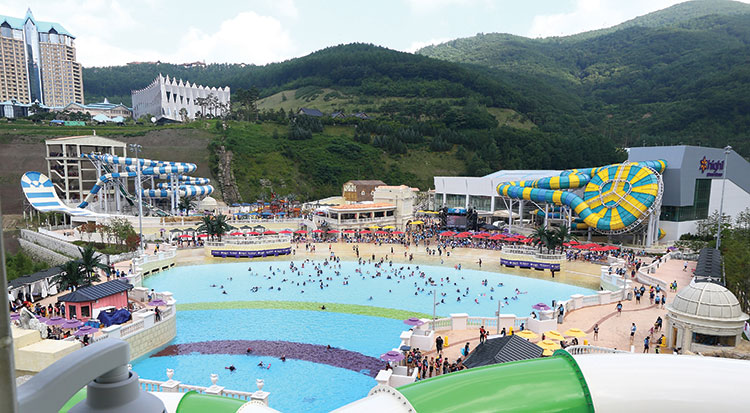
CAP REFITTING
Officials of the National Gaming Control Committee have been working on a revision of the cap formula, set to 0.54% of GDP since 2014, that analysts expect will alleviate some pressure to limit revenue growth. That could lead to opening more tables to alleviate overcrowding and give players a better experience, CGS-CIMB’s Lim believes, setting the stage for renewed growth.
He dismisses any threat of domestic competition when Kangwon Land’s mandated monopoly on Korean play expires in 2025.
“There’s no way there’s going to be local gambling elsewhere,” Lim says, citing public skepticism about expanding gambling and the government’s desire to keep the revenue coming. The real threat, he believes, would come from a Japanese casino that Koreans could fly to in the time it takes to reach Kangwon Land.
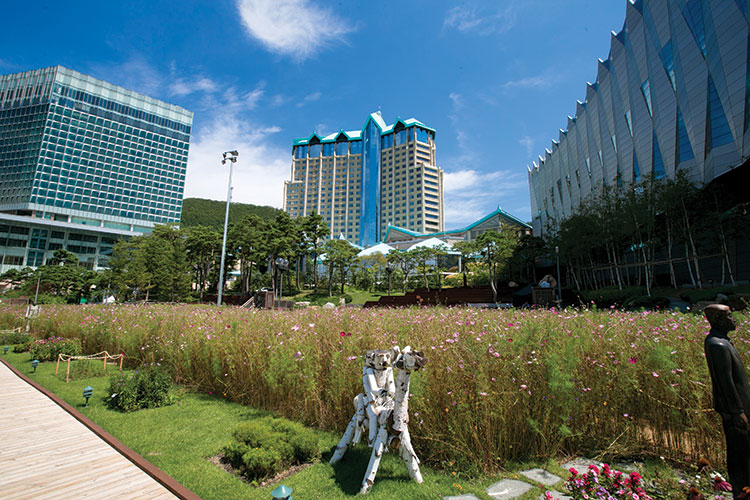 Museum of Slots
Museum of Slots
Kangwon Land’s 1,360 electronic gaming machines range from ancient draw poker machines to contemporary progressive linked products under at least a dozen brand names. However, the betting limit of KRW1,000 (US$0.84) per play presents the biggest challenge to suppliers.
“It’s a very unique market,” IGT Asia Sales Director Michael Cheers says, “very challenging to design games for them.”
IGT was a winner of Kangwon Land’s recent slot tender, its first in three years, on a joint bid with Novomatic, Konami and Aruze for a total of 230 new machines.
Some observers find Kangwon Land’s array of machines baffling, noting that most casinos double down on products that garner the greatest revenue. Cheers sees it differently: “As a government casino, they don’t have to just buy more of what works. They try to give their players diversity.”






